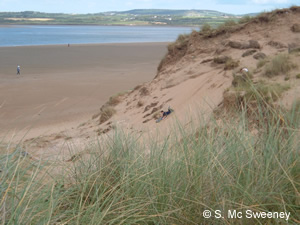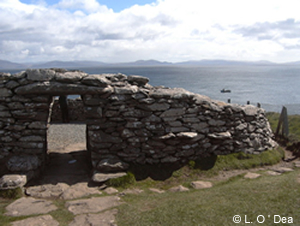CLIMATE CHANGE IMPACTS ON MARINE AND COASTAL HERITAGE
Climate change is firmly recognised as the most significant and threatening global environmental problem. While the world’s climate has always varied naturally there is now widespread acceptance among scientists that rising concentrations of “greenhouse gases” in the Earth’s atmosphere due to human activities are altering this natural variability and leading to changes that may not be reversible, at least in the present century. The Intergovernmental Panel on Climate Change (IPCC) has predicted that global mean surface temperatures will increase by 1.4-5.8°C by 2100. Changes in rainfall patterns are also predicted, increasing the risk of drought or floods in many regions. Overall, the climate is likely to become more variable with a greater threat of extreme weather events.In the marine environment, climate change impacts include increases in sea temperature, storm intensity, wave height and sea level (as the oceans expand and ice melts), as well as possible changes in ocean currents. Such changes may have profound implications for heritage in the marine and coastal area. These changes are likely to include:
 |
| Erosion on Sand Dunes at Tramore Beach, County Waterford |
- Increased intensity of storms and changes in sea level with resulting wave damage on soft shores, e.g. erosion of salt marsh, sand dunes and vegetated shingle areas.
- Rising sea levels will affect the shape of estuaries, which determines intertidal sediments that in turn influence the abundance and availability of the invertebrate prey of water birds. More extensive intertidal flats are likely to become sandier, improving the habitat quality for species such as oystercatcher but reducing it for species such as dunlin.
- Increased seasonal flooding and inundation of low-lying areas, including many important habitat types (e.g. coastal lagoons, machair).
- Increased winter temperatures are likely to lead to a continued northward and eastward shift in the distribution of wader populations. As winters beyond Ireland become milder, a greater proportion of the East Atlantic Flyway populations of some species of wader may over-winter further north and east on the continent of Europe.
- An increase in mean seawater temperature will affect species which currently occur at the extremes of their temperature tolerance range, leading to northerly shifts in the ranges of plankton (read more) and other species (e.g. pilchard, breams), enhanced recruitment of others (e.g. mullet, bass and Pacific oysters) and a decline in some wild populations (e.g. salmonids). On a wider scale it will impact on biodiversity through species losses, new arrivals and greater incidence of invasions of non-native species.
- Increased water temperatures in shallow bays and inlets leading to changes in the structure and stability of plant and animal communities.
- Increases in phytoplankton biomass throughout the year and changes in the timing and intensity of spring algal blooms and the structure of zooplankton communities with possible consequences for marine food chains (read more).
For further information, see the Marine Institute review of the Climate Change Implications for Ireland’s Marine Environment and Resources.
Ongoing
research relating to climate change impacts on heritage
MARCLIM
The Department of Zoology, Ecology and Plant Science, National University
of Ireland, Cork, is the Irish partner in the MarClim project (Marine
Biodiversity and Climate Change). The project is analysing historical
and recent data to establish the extent to which the fauna of rocky seashores
has already changed as a response to climate. Some relevant Irish datasets
exist from Cork (Lough Hyne, Bantry Bay, Kinsale Harbour & Sherkin
Island), Carnsore Point and Clare Island. The project is also developing
models to predict future changes in shore biodiversity. Such predictions
are needed for the conservation, management and protection of the marine
environment. Read more about
MarClim.
MONARCH
The National
Parks and Wildlife Service is a partner in the MONARCH
study – being carried out under the UK Climate Impacts Programme
(UKCIP). The first
phase of the study developed complex computerised models, to estimate
changes in species distribution under climate change conditions. It covered
the impacts of climate change on a broad range of species (including plants,
birds and amphibians) in terrestrial, freshwater, coastal and marine environments
in Britain and Ireland, and considered the implications for nature conservation
policy. A second phase of MONARCH is now underway, to advance the science
of predicting possible responses of species to climate change, by adapting
the previous approach to a local scale. It will take into account factors
such as the suitability of the climate for species distribution, and the
capacity for species dispersal, given potential land use change and restrictions.
The outcomes will then be assessed for selected case study areas. Bird
count data collected from a number of coastal wetland sites as part of
I-WeBS
(Irish Wetland Bird Survey) are being used in the MONARCH climate impact
models.
Continuous
Plankton Recorder Survey
The Continuous
Plankton Recorder (CPR) survey, operated by the Sir Alister Hardy
Foundation for Ocean Sciences (SAHFOS) provides a unique record
of plankton in the north-east Atlantic region. It originated in 1931 and
thus forms one of the longest time-series of marine biological measurements
in the world. CPR sampling has been carried out in Irish waters since
1948. The survey provides data on the patterns and trends in community
structure and distribution and abundance of upper layer plankton at oceanic
scales over several decades and investigates the processes that influence
these patterns. The CPR time series can be used as a ‘barometer’
against which to assess climate change and natural variability. The surveys
are of immense value in making it possible to distinguish between changes
caused by local factors, such as river outflows, and those caused by large-scale
events such as climate change.
Climate Risk
The Coastal and Marine Resources Centre (UCC) are carrying out this study
to model and assess climate change impacts in the coastal zone (Flooding,
Catchment Changes) and their implications on coastal erosion. Read more.
 |
Dunbeg promontory
fort, County Kerry |
There is little specific published material on the topic of climate change and archaeology in Ireland. The growing realization of just how much of our archaeological heritage is being threatened and damaged by existing wave and coastal erosion has been confirmed by surveys undertaken in recent years in Scotland on behalf of Historic Scotland. The implications for coastal and built heritage can be categorized into a number of different influences:
- Increased storm activity has implications for those coastal sites prone to erosion;
- Changes in sea level;
- Seasonal flooding and inundation;
- Coastal defence construction pressures such as construction of sea
walls, gabions, rock armour revetments and groynes.
These influences may result in damage to archaeological features in the coastal zone (e.g. middens) and intertidal (e.g. ish ponds) and subtidal areas (e.g. shipwrecks).
Cork County Council endeavours to protect the Cork coastline where it
is under serious threat from the sea. This is true particularly where
the action of the sea places infrastructure and property in danger. The
prior approval of the Department of Communications, Marine and Natural
Resources must be sought for any proposed coastal protection scheme. The
Council's role in Coastal Protection comprises:
1. Maintenance of existing publicly owned coastal defences such as sea
walls, gabions, rock armour revetments and groynes.
2. Provision of new coastal defences as required in conjunction with grant
aid from the Department of Department of Communications, Marine and Natural
Resources.
Funds for this type of work are limited and priority is given to the protection
of important public infrastructure. The Council does not have a role,
however, in the protection of private property from damage by the sea.
Note: The removal of beach material is strictly forbidden by Ministerial
Order made under the Foreshore Act 1933. This prohibition is enforced
by the County Council and by the Garda Síochána. Signs to
this effect are provided by the Council at locations where problems are
known to exist.
URLs in Text
Greenhouse
Gases - http://www.enfo.ie/leaflets/fs16.htm
Intergovernmental Panel on Climate Change (IPCC) - http:/www.ipcc.ch/
Department of Zoology, Ecology and Plant Science, National University of Ireland, Cork - http://www.ucc.ie/academic/zeps/
MarClim - http:/www.mba.ac.uk/marclim
Monarch Project - http://www.ukcip.org.uk/resources/sector/monarch_p1.asp?sector=3
CPR - http://192.171.163.165/cpr_survey.htm
SAHFOS - www.sahfos.org
Other URLs of InterestDepartment of the Environment, Heritage & Local Government http://www.environ.ie/DOEI/DOEIPol. sf/wvNavView/Climate+Change?OpenDocument&Lang=
Climate Change Programme of the World Conservation Union (IUCN) - http://www.iucn.org/themes/fcp/experience_lessons/climate_iucn_initiative.htm
UNEP World Conservation Monitoring Centre - Biodiversity and Climate Change - http://www.unep-wcmc.org/climate/index.html
United Nations Framework Convention on Climate Change
(UNFCCC): Climate Change Kit
(frequently asked questions on Climate Change) -
http://unfccc.int/essential_background/background_publications_htmlpdf/climate_change_
information_kit/items/305.php
The Pew Center on Global Climate Change - http://www.pewclimate.org/
Handbook on Methods
for Climate Change Impact Assessment and Adaptation Strategies,
Editors: Jan F. Feenstra, Ian Burton, Joel B. Smith, Richard S.J.
Tol, Version 2.0, October, 1998 http://www.decisioncraft.com/energy/papers/hbccia/chap0.pdf
Irish Committee on Climate Change - http://www. ia.ie/committees/iccc/index.html
Climate Change and Sea level (3rd Scientific Statement of the Irish Committee on Climate Change) - http://www. ia.ie/committees/iccc/pdfs/3statement.pdf
Artificial Reefs - http://www.marine.ie/information+services/library+services/marine+institute+publications/
marine+resource+series/r20.pdf
Met Eireann -www.meteireann.ie
National University of
Environmental Research Institute (UCC) - http://www.ucc.ie/en/ERI/
Coastal & Marine Resources Centre (CMRC), UCC - http://cmrc.ucc.ie
Environmental Change Institute (National University of Ireland, Galway) - http://www. uigalway.ie/eci/
UCD Department of Zoology (Marine Biodiversity Laboratory) - http://www.ucd.ie/zoology/marinbiodiversity.htm
http://cmrc.ucc.ie/papers/ENCY%7E%20Ireland%7ERobert%20Devoy.pdf
Selected Further Reading
World Meteorological Organization/United
Nations Environment Programme.Climate Change 2001: The Scientific
Basis.http://www.ipcc.ch/
Sweeney,
J., Donnelly, A., McElwain, L. & Jones, M. (2002).Climate Change:
Indicators for
Sweeney, J., Brereton, T., Byrne, C., Charlton, R., Emblow, C., Fealy, R., Holden, N., Jones, M., Donnelly, A., Moore, S., Purser, P., Byrne, K., Farrell, E., Mayes, E., Minchin, D., Wilson, J. & Wilson, J. (2003).Climate Change: scenarios and impacts for Ireland (2000-LS-5.2.1-M1). Environmental Protection Agency, Wexford.
Hiscock, K., Southward, A., Tittley, I. and Hawkins, S. (2004). Effects of changing temperature on benthic marine life in Britain and Ireland. Aquatic Conserv: Mar. Freshw. Ecosyst., 14: 333-362.
Costello, M.J. and Kelly K.S. (1993). Biogeography of Ireland: past present and future (1993). Occasional Publications of the Irish Biogeographical Society No 2.
Rehfisch. M.M., Feare, .J., Jones, N.J. and Spray, C. (2004). Climate Change and Coastal Birds Ibis Volume 146, Supplement 1. Blackwell Publishing.
Boelens, R., Minchin, D. and O'Sullivan, G. (In Press). Climate Change Implications for Ireland's Marine Environment and Resources , A Strategic Review. Marine Institute, Galway.
O'Sullivan, A. (2001). Foragers, farmers and fishers in a coastal landscape: An intertidal archaeological survey of the Shannon estuary, Royal Irish Academy, Dublin.
McErlean, T. & A. O'Sullivan Foreshore Tidal Fishtraps. (2002). In Strangford Lough: An Archaeological Survey of its Maritime Cultural Landscape, ed. by T. McErlean, R. McConkey and W. Forsythe, Blackstaff Press, Belfast, pp. 144-180.
McCormick, F., M. Gibbons, F. G. McCormac & J. Moore. (1996). Bronze Age To Medieval Coastal Shell Middens near Ballyconneely, Co. Galway. Journal of Irish Archaeology, Volume Vii, 1996. http://www. uigalway.ie/jia/